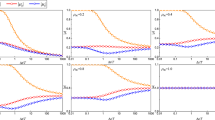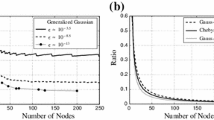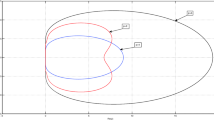Abstract
In this paper, a new family of explicit and implicit multistep methods is presented both for the error-controlled and uncontrolled modes. The main concept is to replace the Newton interpolation with the Hermite interpolation, where the Hermite polynomial is fitted to the function values and its derivatives. This idea is very useful in the numerical solution of problems (e.g., orbit propagation problem) where higher-order derivatives can easily be computed. In addition to the theoretical concept, the stability regions of the proposed methods are determined. The new methods are more stable than the well-known multistep numerical integrators (i.e., Adams–Bashforth and Adams–Bashforth–Moulton) in the explicit, implicit, and predictor–corrector forms. Using the second-order derivatives gives smaller error constants in the proposed method. The new integrators are numerically tested for a few examples, and the solutions are compared with those of the well-known multistep methods. Moreover, the CPU time and absolute integration error are compared in the satellite orbit propagation problem using various integration methods. The CHAMP mission, i.e., a German small-satellite mission for geoscientific and atmospheric research and applications, is considered as a case study for comparing the achievable accuracy of the proposed method with the existing method for solving the two-body problem.







Similar content being viewed by others
References
Bashforth, F., Adams, J.C.: An Attempt to Test the Theories of Capillary Action by Comparing the Theoretical and Measured Forms of Drops of Fluid, with an Explanation of the Method of Integration Employed in Constructing the Tables Which Give the Theoretical Forms of Such Drops. Cambridge University Press, Cambridge (1883)
Butcher, J.C.: The Numerical Analysis of Ordinary Differential Equations. Wiley, New York (1987)
Butcher, J.C.: Numerical methods for ordinary differential equations in the twentieth century. J. Comput. Appl. Math. 125, 1–29 (2000)
Beutler, G.: Methods of Celestial Mechanics. Vol. I: Physical, Mathematical, and Numerical Principles. Springer, Berlin (2005)
Chihara, T.S.: An Introduction to Orthogonal Polynomials. Gordon & Breach, New York (1978)
Chakravarti, P.C., Kamel, M.S.: Stiffly stable second derivative multistep methods with higher order and improved stability region. BIT 23, 75–83 (1983)
Conte, S.D., de Boor, C.: Elementary Numerical Analysis. McGraw-Hill, New York (1980)
Curtis, L.E.: High order explicit Runge–Kutta formulae, their uses, and limitations. J. Inst. Math. Appl. 16, 35–55 (1975)
Curtiss, C.F., Hirschfelder, J.O.: Integration of stiff equations. Proc. Nat. Acad. Sci. 38, 235–243 (1952)
Dahlquist, G.: Convergence and stability in the numerical integration of ordinary differential equations. Math. Scand. 4, 33–53 (1956)
Dormand, J.R., Prince, P.J.: New Runge–Kutta algorithms for numerical simulation in dynamical astronomy. Celest. Mech. 18, 223–232 (1978)
Dormand, J.R., Prince, P.J.: A family of embedded Runge–Kutta formulae. J. Comp. Appl. Math. 6(1), 19–26 (1980). doi:10.1016/0771-050X(80)90013-3
Dormand, J.R., Mikkawy, M.E.A., Prince, P.J.: High-order embedded Runge–Kutta–Nystrom formulae. IMA J. Numer. Anal. 7, 423–430 (1987)
Enright, W.H.: Second derivative multistep methods for stiff ordinary differential equations. SIAM J. Numer. Anal. 11, 321–331 (1974)
Enright, W.H., Higham, D.J.: Parallel defect control. BIT Numer. Math. 31, 647–663 (1991)
Fasano, G., D’Errico, M.: Modeling orbital relative motion to enable formation design from application requirements. Celest. Mech. Dyn. Astron. 105, 113–139 (2009). doi:10.1007/s10569-009-9230-5
Forrington, C.V.D.: Extensions of the predictor-corrector method for the solution of systems of ordinary differential equations. Comput. J. 4, 80–84 (1962)
Filippi, S., Graf, J.: New Runge–Kutta–Nystrom formula-pairs of order 8(7), 9(8), 10(9) and 11(10) for differential equations of the form \(y^{\prime \prime } = f(x, y)\). J. Comput. Appl. Math. 14, 361–370 (1986)
Glaser, A., Rokhlin, V.: A new class of highly accurate solvers for ordinary differential equations. J. Sci. Comput. 38, 368–399 (2009). doi:10.1007/s10915-008-9245-1
Garrappa, R.: On some explicit Adams multistep methods for fractional differential equations. J. Comput. Appl. Math. 229, 392–399 (2009)
Gupta, G.K.: Implementing second derivative multistep methods using the Nordsieck polynomial representation. Math. Comp. 32, 13–18 (1978)
Hairer, E.: A Runge–Kutta method of order 10. J. Inst. Math. Appl. 21, 47–59 (1978)
Hairer, E., Norsett, S.P., Wanner, G.: Solving Ordinary Differential Equations I, 2nd edn. Springer, Berlin (1993)
Hairer, E., Wanner, G.: Solving Ordinary Differential Equations II: Stiff and Differential-Algebraic Problems. Springer, Berlin (1996)
Hermite, Ch.: Extrait d’une lettre de M. Ch. Hermite a M. Borchardt sur la formule d’interpolation de Lagrange. J. de Crelle. 84, 432–443 (1878)
Heun, K.: Neue Methoden zur approximativen Integration der Dierentialgleichungen einer unabh angigen Ver anderlichen. Z. Math. Phys. 45, 23–38 (1900)
Hojjati, G., Rahimi Ardabili, M.Y., Hosseini, S.M.: New second derivative multistep methods for stiff system. Appl. Math. Model. 30, 466–476 (2006)
Ismail, G., Ibrahim, I.: New efficient second derivative multistep methods for stiff systems. Appl. Math. Model. 23, 279–288 (1999)
Kirlinger, G.: Linear multistep methods applied to stiff initial value problems-A survey. Math. Comput. Modell. 40, 1181–1192 (2004)
Kowali, S., Gupta, G.K.: Polynomial formulation of second derivative multistep. Math. Comput. 38(158), 447–458 (1982)
Kutta, W.: Beitrag zur näherungsweisen Integration totaler Differentialgleichungen. Z. Math. Phys. 46, 435–453 (1901)
Lambert, J.D.: Computational Methods in Ordinary Differential Equations. Wiley, New York (1972)
LeVeque, R.J.: Finite Difference Methods for Ordinary and Partial Differential Equations. SIAM, Philadelphia (2007)
Prince, P.J., Dormand, J.R.: High order embedded Runge–Kutta formulae. J. Comp. Appl. Math. 7, 67–75 (1981)
Mitchell, A.R., Craggs, J.W.: Stability of difference relations in the solution of ordinary differential equations. Math. Tables Aids Comput. 7, 127–129 (1953)
Milne, W.E.: Numerical integration of ordinary differential equations. Am. Math. Monthly. 33, 455–460 (1926)
Montenbruck, O., Gill, E.: Satellite Orbits-Models, Methods, and Applications. Springer, Berlin (2000)
Moulton, F.R.: New Methods in Exterior Balistics. University of Chicago, Chicago (1926)
Nystrom, E.J.: Uber die numerische Integration von Differentialgleichungen. Acta Soc. Sci. Fennicae. 50(13), 1–55 (1925)
Nguyen-Ba, T., Vaillancourt, R.: Hermite–Birkhoff–Obrechkoff 3-stage 6-step ODE solver of order 14. Can. Appl. Math. Q. 13(2), 151–181 (2005)
Nguyen-Ba, T., Yagoub, H., Zhang, Y., Vaillancourt, R.: Variable-step variable-order 3-stage Hermite–Birkhoff–Obrechkoff ODE solver of order 4 to 14. Can. Appl. Math. Q. 14(4), 413–437 (2006)
Nguyen-Ba, T., Sharp, P.W., Yagoub, H., Vaillancourt, R.: Hermite–Birkhoff–Obrechkoff 3-stage 4-step ODE solver of order 14 with quantized stepsize. Can. Appl. Math. Q. 15(2), 181–201 (2007)
Nguyen-Ba, T., Yagoub, H., Zhang, Y., Vaillancourt, R.: Variable-step-variable-order 2-stage Hermite–Birkhoff–Obrechkoff ODE solver of order 3 to 14. Sci Proc Riga Tech Univ 37(50), 79–102 (2008a)
Nguyen-Ba, T., Sharp, P.W., Vaillancourt, R.: Hermite–Birkhoff–Obrechkoff 4-stage 4-step ODE solver of order 14 with quantized stepsize. J. Comput. App. Math. 222(2), 608–621 (2008b)
Nguyen-Ba, T., Bozic, V., Kengne, E., Vaillancourt, R.: One-step 9-stage Hermite–Birkhoff–Taylor ODE solver of order 10. J. Appl. Math. Comput. 31, 335–358 (2009). doi:10.1007/s12190-008-0216-3
Nguyen-Ba, T., Yagoub, H., Hao, H., Vaillancourt, R.: Pryce pre-analysis adapted to some DAE solvers. Appl. Math. Comput. 217, 8403–8418 (2011). doi:10.1016/j.amc.2011.03.037
Nguyen-Ba, T., Desjardins, S.J., Sharp, P.W., Vaillancourt, R.: Contractivity-preserving explicit Hermite–Obrechkoff ODE solver of order 13. Celest. Mech. Dyn. Astron. 117 (2013). doi:10.1007/s10569-013-9520-9
Quarteroni, A., Fausto, S., Gervasio, P.: Scientific Computing with MATLAB and Octave, 3rd edn. Springer, Berlin (2010)
Reigber, C., Luhr, H., Schwintzer, P.: CHAMP mission status. Adv. Space Res. 30(2), 129–134 (2002)
Runge, C.: Über die numerische Auflösung von Differentialgleichungen. Math. Ann. 46, 167–178 (1895)
Shampine, L.F.: Error Estimation and Control for ODEs. J. Sci. Comput. 25(1/2) (2005). DOI:10.1007/s10915-004-4629-3
Shampine, L.F., Reichelt, M.W.: The MATLAB ODE suite. SIAM J. Sci. Comput. 18, 1–22 (1997)
Shokri, A., Shokri, A.: The new class of implicit L-stable hybrid Obrechkoff method for the numerical solution of first order initial value problems. Comput. Phys. 184, 529–531 (2013)
Slonevsky, R.V., Stolyarchuk, R.R.: Evaluation of the local error of fractional–rational multistep methods with variable integration step. J. Math. Sci. 178, 399–408 (2011)
Seeber, G.: Satellite Geodesy. Walter de Gruyter, Berlin (2003)
Yang, W.Y., Cao, W., Chung, T., Morris, J.: Applied Numerical Methods Using Matlab. Wiley, New Jersey (2005)
Author information
Authors and Affiliations
Corresponding author
Appendix
Appendix
1.1 Backward difference
The difference approximation could be achieved using Taylor series. If \(f_{k-1}\) and \({f}^{\prime }_{k-1}\) are expanded to Taylor series, then we have
where
The \(f_k^{(2)}\) could be computed from the following equation:
Similarly, \(f_k^{(3)}\)
Rights and permissions
About this article
Cite this article
Sharifi, M.A., Seif, M.R. A new family of multistep numerical integration methods based on Hermite interpolation. Celest Mech Dyn Astr 118, 29–48 (2014). https://doi.org/10.1007/s10569-013-9517-4
Received:
Accepted:
Published:
Issue Date:
DOI: https://doi.org/10.1007/s10569-013-9517-4




